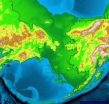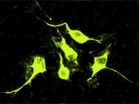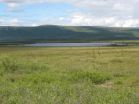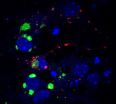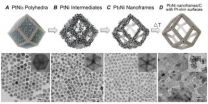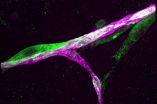(Press-News.org) SALT LAKE CITY, Feb. 27, 2014 – Genetic and environmental evidence indicates that after the ancestors of Native Americans left Asia, they spent 10,000 years in shrubby lowlands on a broad land bridge that once linked Siberia and Alaska. Archaeological evidence is lacking because it drowned beneath the Bering Sea when sea levels rose.
University of Utah anthropologist Dennis O'Rourke and two colleagues make that argument in the Friday, Feb. 28, issue of the journal Science. They seek to reconcile existing genetic and paleoenvironmental evidence for human habitation on the Bering land bridge – also called Beringia – with an absence of archaeological evidence.
O'Rourke says cumulative evidence indicates the ancestors of Native Americans lived on the Bering land bridge "in the neighborhood of 10,000 years," from roughly 25,000 years ago until they began moving into the Americas about 15,000 years ago once glacial ice sheets melted and opened migration routes.
O'Rourke co-authored the Science Perspective column – titled "Out of Beringia?" – with archaeologist John Hoffecker of the University of Colorado at Boulder, and Scott Elias, a paleoecologist at the University of London. Perspective columns in Science don't feature research by the authors, but instead are meant to highlight and provide context for exciting new research in a field or across fields.
"Nobody disputes that the ancestors of Native American peoples came from Asia over the coast and interior of the land bridge" during an ice age called the "last glacial maximum," which lasted from 28,000 to at least 18,000 years ago, O'Rourke says,
The ice sheets extended south into the Pacific Northwest, Wyoming, Wisconsin and Ohio. Large expanses of Siberia and Beringia were cold but lacked glaciers.
The absence of archaeological sites and the inhospitable nature of open, treeless landscape known as tundra steppe mean that "archaeologists have not given much credence to the idea there was a population that lived on the Bering land bridge for thousands of years," he adds.
O'Rourke and colleagues say that in recent years, paleoecologists – scientists who study ancient environments – drilled sediment cores from the Bering Sea and Alaskan bogs. Those sediments contain pollen, plant and insect fossils, suggesting the Bering land bridge wasn't just barren, grassy tundra steppe but was dotted by "refugia" or refuges where there were brushy shrubs and even trees such as spruce, birch, willow and alder.
"We're putting it together with the archaeology and genetics that speak to American origins and saying, look, there was an environment with trees and shrubs that was very different than the open, grassy steppe. It was an area where people could have had resources, lived and persisted through the last glacial maximum in Beringia," O'Rourke says. "That may have been critical for the people to subsist because they would have had wood for construction and for fires. Otherwise, they would have had to use bone, which is difficult to burn."
A Frozen, Isolated Dawn for the Earliest Americans
During the last glacial maximum, thick glacial ice sheets extended south into what now is the northern United States, sea levels dropped some 400 feet, O'Rourke says. As the glaciers melted, sea levels began to rise, reaching current levels 6,000 years ago.
During the long glacial period, Siberia and Alaska were linked by the Bering land bridge, which contrary to the name's implication, really was a huge swath of land north, between and south of Siberia and Alaska, at the present sites of the Chukchi Sea, the Bering Strait and the Bering Sea, respectively.
At its largest extent, Beringia measured as much as 1,000 miles from north to south and as much as 3,000 miles from Siberia's Verkoyansk Range east to the Mackenzie River in in Canada.
The theory that humans inhabited the Bering land bridge for some 10,000 years "helps explain how a Native American genome (genetic blueprint) became separate from its Asian ancestor," O'Rourke says.
"At some point, the genetic blueprint that defines Native American populations had to become distinct from that Asian ancestry," he explains. "The only way to do that was for the population to be isolated. Most of us don't believe that isolation took place in Siberia because we don't see a place where a population could be sufficiently isolated. It would always have been in contact with other Asian groups on its periphery."
"But if there were these shrub-tundra refugia in central Beringia, that provided a place where isolation could occur" due to distance from Siberia, O'Rourke says.
Genetic and Paleoenvironmental Evidence
O'Rourke and colleagues point to a study of mitochondrial DNA – genetic information passed by mothers – sampled from Native Americans throughout the Americas. The study found that the unique genome or genetic blueprint of Native Americans arose sometime before 25,000 years ago but didn't spread through the Americas until about 15,000 years ago.
"This result indicated that a substantial population existed somewhere, in isolation from the rest of Asia, while its genome differentiated from the parental Asian genome," O'Rourke says. "The researchers suggested Beringia as the location for this isolated population, and suggested it existed there for several thousand years before members of the population migrated southward into the rest of North and, ultimately, South America as retreating glaciers provided routes for southern migration."
"Several other genetic-genomic analyses of Native American populations have resulted in similar conclusions," he adds.
"For a long time, many of us thought the land bridge was a uniform tundra-steppe environment" – a broad windswept grassland devoid of shrubs and trees, O'Rourke says. But in recent years, sediment cores drilled in the Bering Sea and along the Alaskan coast – the now-submerged lowlands of Beringia – found pollens of trees and shrubs.
That "suggests Beringia was not a uniform tundra-steppe environment, but a patchwork of environments, including substantial areas of lowland shrub tundra," O'Rourke says. "These shrub-tundra areas were likely refugia for a population that would be invisible archaeologically, since the former Beringian lowlands are now submerged."
"Large herd animals like bison or mammoths likely lived on the highland steppe tundra because they graze. Many smaller animals, birds, elk and moose (which browse shrubs instead of grazing on grass) would have been in the shrub tundra," he adds.
Other research indicates "that much of Beringia – particularly the lowlands – appears to have had average summer temperatures nearly identical (or only slightly cooler in some regions) to those in the region today," O'Rourke says. "The local environments likely were not as daunting as many have assumed for years. They probably hunkered down pretty good in the winter though. It would have been cold."
The idea that rising sea levels covered evidence of human migration to the Americas has long been cited by researchers studying how early Native Americans moved south along the Pacific coast as the glaciers receded and sea levels rose. O'Rourke says the idea hasn't been used before to explain the scarcity of archaeological sites in Alaska and Siberia, which were highlands when the land bridge was exposed.
But O'Rourke and his colleagues say archaeological sites must be found in Beringia if the long human layover there is to be confirmed. Although most such sites are underwater, some evidence of human habitation in shrub tundra might remain above sea level in low-lying portions of Alaska and eastern Chukotka (in Russia)."
INFORMATION:
University of Utah Communications
75 Fort Douglas Boulevard, Salt Lake City, UT 84113
801-581-6773 fax: 801-585-3350
http://www.unews.utah.edu
10,000 years on the Bering land bridge
Ancestors of Native Americans paused en route from Asia
2014-02-27
ELSE PRESS RELEASES FROM THIS DATE:
A bird's eye view of cellular RNAs
2014-02-27
BOSTON -- In biology, as in real estate, location matters. Working copies of active genes -- called messenger RNAs or mRNAs -- are positioned strategically throughout living tissues, and their location often helps regulate how cells and tissues grow and develop. But to analyze many mRNAs simultaneously, scientists have had to grind cells to a pulp, which left them no good way to pinpoint where those mRNAs sat within the cell.
Now a team at the Wyss Institute of Biologically Inspired Engineering at Harvard University and Harvard Medical School, in collaboration with ...
Scientists uncover trigger for most common form of intellectual disability and autism
2014-02-27
NEW YORK (February 27, 2014) -- A new study led by Weill Cornell Medical College scientists shows that the most common genetic form of mental retardation and autism occurs because of a mechanism that shuts off the gene associated with the disease. The findings, published today in Science, also show that a drug that blocks this silencing mechanism can prevent fragile X syndrome – suggesting similar therapy is possible for 20 other diseases that range from mental retardation to multisystem failure.
Fragile X syndrome occurs mostly in boys, causing intellectual disability ...
CU-led study says Bering Land Bridge a long-term refuge for early Americans
2014-02-27
A new study led by the University of Colorado Boulder bolsters the theory that the first Americans, who are believed to have come over from northeast Asia during the last ice age, may have been isolated on the Bering Land Bridge for thousands of years before spreading throughout the Americas.
The theory, now known as the "Beringia Standstill," was first proposed in 1997 by two Latin American geneticists and refined in 2007 by a team led by the University of Tartu in Estonia that sampled mitrochondrial DNA from more than 600 Native Americans. The researchers found that ...
Fossils offer new clues into Native American's 'journey' and how they survived the last Ice Age
2014-02-27
Researchers have discovered how Native Americans may have survived the last Ice Age after splitting from their Asian relatives 25,000 years ago.
Academics at Royal Holloway, University of London, and the Universities of Colorado and Utah have analysed fossils which revealed that the ancestors of Native Americans may have set up home in a region between Siberia and Alaska which contained woody plants that they could use to make fires. The discovery breaks new ground as until now no-one had any idea of where the native Americans spent the next 10,000 years before they appeared ...
Researchers reveal the dual role of brain glycogen
2014-02-27
In 2007, in an article published in Nature Neuroscience, scientists at the Institute for Research in Biomedicine (IRB Barcelona) headed by Joan Guinovart, an authority on glycogen metabolism, reported that in Lafora Disease (LD), a rare and fatal neurodegenerative condition that affects adolescents, neurons die as a result of the accumulation of glycogen—chains of glucose. They went on to propose that this accumulation is the root cause of this disease.
The breakthrough of this paper was two-sided: first, the researchers established a possible cause of LD and therefore ...
UCSB study reveals evolution at work
2014-02-27
New research by UC Santa Barbara's Kenneth S. Kosik, Harriman Professor of Neuroscience, reveals some very unique evolutionary innovations in the primate brain.
In a study published online today in the journal Neuron, Kosik and colleagues describe the role of microRNAs — so named because they contain only 22 nucleotides — in a portion of the brain called the outer subventricular zone (OSVZ). These microRNAs belong to a special category of noncoding genes, which prevent the formation of proteins.
"It's microRNAs that provide the wiring diagram, dictating which genes ...
Big step for next-generation fuel cells and electrolyzers
2014-02-27
A big step in the development of next-generation fuel cells and water-alkali electrolyzers has been achieved with the discovery of a new class of bimetallic nanocatalysts that are an order of magnitude higher in activity than the target set by the U.S. Department of Energy (DOE) for 2017. The new catalysts, hollow polyhedral nanoframes of platinum and nickel, feature a three-dimensional catalytic surface activity that makes them significantly more efficient and far less expensive than the best platinum catalysts used in today's fuel cells and alkaline electrolyzers. This ...
Fossilized human feces from 14th century contain antibiotic resistance genes
2014-02-27
A team of French investigators has discovered viruses containing genes for antibiotic resistance in a fossilized fecal sample from 14th century Belgium, long before antibiotics were used in medicine. They publish their findings ahead of print in the journal Applied and Environmental Microbiology.
"This is the first paper to analyze an ancient DNA viral metagenome," says Rebecca Vega Thurber of Oregon State University, Corvallis, who was not involved in the research.
The viruses in the fecal sample are phages, which are viruses that infect bacteria, rather than infecting ...
Physicians' stethoscopes more contaminated than palms of their hands
2014-02-27
VIDEO:
A comparative analysis shows that stethoscope diaphragms are more contaminated than the physician's own thenar eminence (group of muscles in the palm of the hand) following a physical examination.
Click here for more information.
Rochester, MN, February 27, 2014 – Although healthcare workers' hands are the main source of bacterial transmission in hospitals, physicians' stethoscopes appear to play a role. To explore this question, investigators at the University of ...
Study reveals mechanisms cancer cells use to establish metastatic brain tumors
2014-02-27
NEW YORK, NY, February 27, 2014 — New research from Memorial Sloan Kettering provides fresh insight into the biologic mechanisms that individual cancer cells use to metastasize to the brain. Published in the February 27 issue of Cell, the study found that tumor cells that reach the brain — and successfully grow into new tumors — hug capillaries and express specific proteins that overcome the brain's natural defense against metastatic invasion.
Metastasis, the process that allows some cancer cells to break off from their tumor of origin and take root in a different tissue, ...
LAST 30 PRESS RELEASES:
Numbers in our sights affect how we perceive space
SIMJ announces global collaborative book project in commemoration of its 75th anniversary
Air pollution exposure and birth weight
Obstructive sleep apnea risk and mental health conditions among older adults
How talking slows eye movements behind the wheel
The Ceramic Society of Japan’s Oxoate Ceramics Research Association launches new international book project
Heart-brain connection: international study reveals the role of the vagus nerve in keeping the heart young
Researchers identify Rb1 as a predictive biomarker for a new therapeutic strategy in some breast cancers
Survey reveals ethical gaps slowing AI adoption in pediatric surgery
Stimulant ADHD medications work differently than thought
AI overestimates how smart people are, according to HSE economists
HSE researchers create genome-wide map of quadruplexes
Scientists boost cell "powerhouses" to burn more calories
Automatic label checking: The missing step in making reliable medical AI
Low daily alcohol intake linked to 50% heightened mouth cancer risk in India
American Meteorological Society announces Rick Spinrad as 2026 President-Elect
Biomass-based carbon capture spotlighted in newly released global climate webinar recording
Illuminating invisible nano pollutants: advanced bioimaging tracks the full journey of emerging nanoscale contaminants in living systems
How does age affect recovery from spinal cord injury?
Novel AI tool offers prognosis for patients with head and neck cancer
Fathers’ microplastic exposure tied to their children’s metabolic problems
Research validates laboratory model for studying high-grade serous ovarian cancer
SIR 2026 delivers transformative breakthroughs in minimally invasive medicine to improve patient care
Stem Cell Reports most downloaded papers of 2025 highlight the breadth and impact of stem cell research
Oxford-led study estimates NHS spends around 3% of its primary and secondary care budget on the health impacts of heat and cold in England
A researcher’s long quest leads to a smart composite breakthrough
Urban wild bees act as “microbial sensors” of city health.
New study finds where you live affects recovery after a hip fracture
Forecasting the impact of fully automated vehicle adoption on US road traffic injuries
Alcohol-related hospitalizations from 2016 to 2022
[Press-News.org] 10,000 years on the Bering land bridgeAncestors of Native Americans paused en route from Asia

